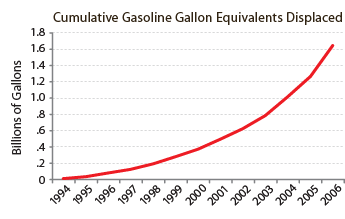Mission and Background
What is Clean Cities? Fact Sheet (PDF 2 MB) Download Adobe Reader.
The mission of Clean Cities is to advance the energy, economic, and environmental security of the United States by supporting local decision to adopt practices that reduce the use of petroleum in the transportation sector. Clean Cities coordinators lead local geographically-based coalitions composed of local fleets, fuel providers, and decision-makers that focus on a united goal: petroleum reduction. There are nearly 90 coalitions representing 126 million U.S. citizens—approximately 63% of the country's total population. Since its inception in 1993, Clean Cities and its stakeholders have displaced more than 1.2 billion gallons of petroleum.

While initially focused solely on alternative fuels, Clean Cities expanded to include other relevant technologies. The five Clean Cities technologies are:
- Alternative fuels and vehicles
- Hybrid electric vehicles
- Idle reduction technologies
- Fuel economy measures
- Low-level fuel blends
Clean Cities coalitions determine which combinations of the five technologies will best help their cities and regions reduce petroleum consumption. The U.S. Department of Energy provides direction for coalitions by establishing goals that can be achieved through the framework of technologies.
Clean Cities also developed and maintains the Alternative Fuels and Advanced Vehicles Data Center, a robust Web site that features information and tools related to Clean Cities' transportation technologies areas.
Goals
The goal of Clean Cities is to expand and stimulate alternative fuel and advanced technology markets to reduce petroleum consumption by 2.5 billion gallons by 2020. Clean Cities is focusing on three primary methods to achieve this goal:
-
Replacement: Replacing petroleum used in the transportation sector with alternative fuels and low-level blends of non-petroleum replacement fuels.
-
Reduction: Reducing petroleum use by promoting energy efficiency in vehicles through advanced technology and efficient vehicles.
-
Elimination: Eliminating petroleum or other fuel use by promoting advanced technologies and greater use of mass transit systems, trip elimination measures, and other congestion mitigation approaches.
International
Clean Cities shares its petroleum displacement mission and goals with international groups in India, Peru, and the Philippines. It works with national governments, U.S. industry, and worldwide partners to establish a foundation for viable alternative fuels markets. In this role, Clean Cities hosts delegations, provides technical training with leveraged resources, and shares its model to support world-wide acceptance of alternative fuels and vehicles.












